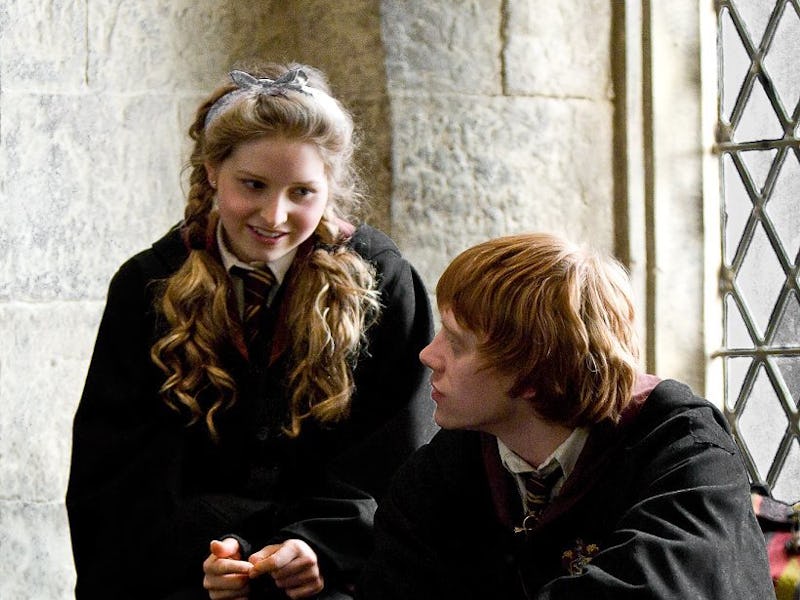Why Lavender Brown Is The Most Slept-On Harry Potter Character
On the twentieth anniversary of Harry Potter, it's time for Lavender Brown to get justice.

Of all the side characters populating the Harry Potter series, Lavender Brown is hardly a fan favorite. She isn’t endearingly quirky like Luna Lovegood, fun like Tonks, or tragic like Sirius Black. In fact, she’s rather vapid. But on the twentieth anniversary of the first book’s release, it’s time to reassess Harry’s most misunderstood classmate.
Lavender has earned her bad rep because she’s the antithesis of the Cool Girl archetype. She simpers over her first boyfriend, gives him a silly nickname (“Won-Won”), doesn’t take the hint that he’s just not that into her. She’s coded as less intelligent because she puts stock in Professor Trelawney — who real students like Hermione write off as useless. Frivolous and clueless, Lavender is every worst teen girl stereotype wrapped in a pink bow.
But if we take a look at teen girl stereotypes and Lavender’s ending, the story changes.
During the Battle of Hogwarts at the end of Harry Potter and the Deathly Hallows, Lavender is attacked by the vicious werewolf Fenrir Greyback. He’s responsible for Bill Weasley’s scars and Remus Lupin’s Lycanthropy. Curiously, in the book her last appearance is lying on the floor mangled “stirring feebly” but in the movie she’s killed.
As a result of this discrepancy, fans still argue about whether she really died. The general consensus is that she survived, which means she’s living like Bill Weasley — barring cursed scars that will never heal.
Let’s assume it’s the latter option, since J.K. Rowling has never confirmed her death. The woman sure likes to make post-series statements, so there’s no reason she would be shy about eulogizing Lavender if it’s called for.
During her sixth year at Hogwarts, Lavender threw herself into her short-lived and ill-fated relationship with Ron with the same kind of fervor that perpetuates modern teen girls rallying around boybands or various fandoms.
In fact, if Lavender was a contemporary teen girl there’s no question that she’d be involved in some kind of fandom where she surfed Tumblr, shipping fictional couples and posting gifs of hot guys.
The rest of society looks at teen girl fandom with bemused scorn, but for those who engage in it, participating in fandom is often a safe first arena for them to discover social justice, and explore their own ways of participating in society.
Of course, in the world of Harry Potter, Werewolves are among the most marginalized. Lupin is frequently unemployed because they’re discriminated against in the job market, and government officials like Umbridge try to pass Anti-Werewolf legislation. And just by existing with visible marks from a Werewolf, Lavender is now thrown into this marginalized sub-faction. It’s a bitter punishment for a girl whose only crime is being embarrassing about her first crush when she was sixteen.
But her behavior in Harry Potter means she’s ripe for the kind of teen-girl fervor that segues into social justice. Lavender’s way of participating is going all-in on whatever she’s enthusiastic about. The very fact that she stayed to fight in the Battle of Hogwarts says she cares about more than boys and Witch Weekly. She’d channel the same energy she used when she dated “Won-Won” for the new area of her life that’s most important.
Does this mean she’s a freedom fighter, leading the fight for Werewolf equality? Only J.K. Rowling could say that. She might simply be going about her life, sadder and more woke than she was before.
But on the twentieth anniversary of Harry Potter, it’s time to recognize Lavender Brown as the anti-Cool Girl. She has absolutely no chill and gets a ruder awakening than she deserves. Luna Lovegood and Hermione Granger are the girls everyone wants as their best friends — but Lavender Brown is that part of everyone at sixteen that’s buried by adulthood.
As Harry himself learns, being cool is overrated.